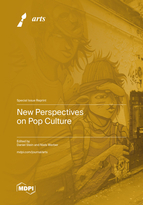New Perspectives on Pop Culture
A special issue of Arts (ISSN 2076-0752).
Deadline for manuscript submissions: closed (15 October 2022) | Viewed by 39116
Special Issue Editors
Interests: American studies; popular culture; seriality; comics and graphic narrative
Special Issue Information
Dear Colleagues,
Popular culture has long been identified either as the expression of working class or common folk or as the lowly substratum of an idealized high culture; thus, the emergence of a media-crossing pop aesthetic in the 1950s marked the beginning of a whole-scale social and cultural transformation. As an aesthetics of surfaces and artificiality, of the somatic, the serial and mass-produced, the “zany, cute, and interesting” (Ngai 2012), pop has amplified the ambivalence of the popular, for instance, its qualitative connotations of the simple and trivial or the resistant and subversive, as well as its quantitative claims of being better known, more commercially successful, and more widely disseminated than that which is not popular.
The quantitative and qualitative components of the popular inevitably intersect if we assume that the simple and trivial can attract the attention of large audiences, because it requires no effort on the part of the recipients. According to this approach, popular culture is always low culture. That this is not the case becomes apparent when works of high culture make bestseller lists or when institutions of high culture seek popularity—when museums, opera houses, quality publishing houses, or theaters aim to attract the attention of many to justify their existence. The result of this process is the disruption of the established distinction between low culture and high culture, as these institutions would not claim that their popular exhibitions, concerts, publications, or performances are trivial.
With the popularization of the Internet in around 2000 and our current digital, algorithm-driven culture and its constant display of the metrics of popularity (likes, retweets, views; rankings, charts, hit-lists), the disruption of high/low distinctions has clearly intensified. In fact, pop’s popularity is putting pressure on the institutions of high culture, whose reactions range from accommodation and resilience to outright resistance. These developments call for new approaches to the study of popular culture.
We invite original articles that account for the role of pop in the transformation of the popular. We are particularly interested in work that examines the dissolution of high/low distinctions and for innovative analyses of pop as part of digital culture. Contributions that focus on the prehistory of these developments are also welcome.
Prof. Dr. Daniel Stein
Prof. Dr. Niels Werber
Guest Editors
Manuscript Submission Information
Manuscripts should be submitted online at www.mdpi.com by registering and logging in to this website. Once you are registered, click here to go to the submission form. Manuscripts can be submitted until the deadline. All submissions that pass pre-check are peer-reviewed. Accepted papers will be published continuously in the journal (as soon as accepted) and will be listed together on the special issue website. Research articles, review articles as well as short communications are invited. For planned papers, a title and short abstract (about 100 words) can be sent to the Editorial Office for announcement on this website.
Submitted manuscripts should not have been published previously, nor be under consideration for publication elsewhere (except conference proceedings papers). All manuscripts are thoroughly refereed through a double-blind peer-review process. A guide for authors and other relevant information for submission of manuscripts is available on the Instructions for Authors page. Arts is an international peer-reviewed open access semimonthly journal published by MDPI.
Please visit the Instructions for Authors page before submitting a manuscript. The Article Processing Charge (APC) for publication in this open access journal is 1400 CHF (Swiss Francs). Submitted papers should be well formatted and use good English. Authors may use MDPI's English editing service prior to publication or during author revisions.
Keywords
- pop aesthetics
- quantitative and qualitative popularity
- metrics of popularity
- charts and bestseller lists
- high/low distinctions
- accommodation, resilience, resistance
- algorithms and digital culture






